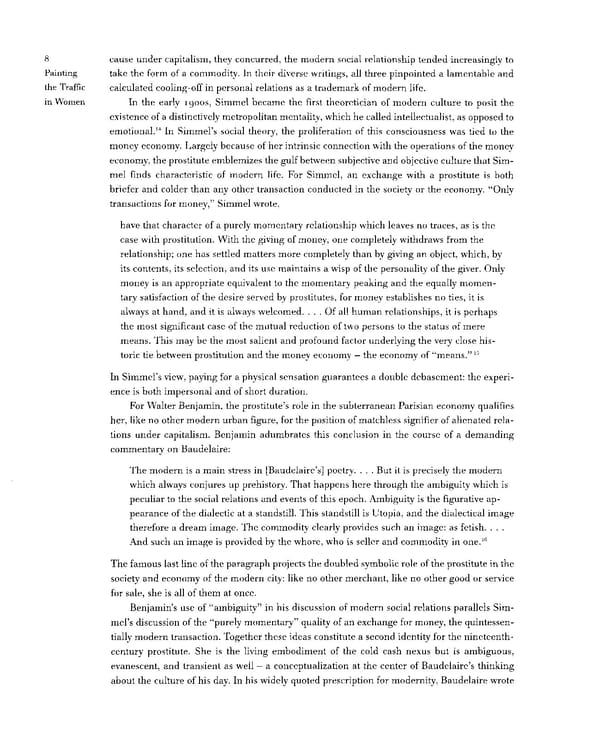8 cause under capitalism, they concurred, the modern social relationship tended increasingly to Painting take the form of a commodity. In their diverse writings, all three pinpointed a lamentable and the Traffic calculated cooling-off in personal relations as a trademark of modern life. in Women In the early igoos, Simmel became the first theoretician of modern culture to posit the existence of a distinctively metropolitan mentality, which he called intellectualist, as opposed to 14 emotional. In Simmel's social theory, the proliferation of this consciousness was tied to the money economy. Largely because of her intrinsic connection with the operations of the money economy, the prostitute emblemizes the gulf between subjective and objective culture that Sim- mel finds characteristic of modern life. For Simmel, an exchange with a prostitute is both briefer and colder than any other transaction conducted in the society or the economy. "Only transactions for money," Simmel wrote, have that character of a purely momentary relationship which leaves no traces, as is the case with prostitution. With the giving of money, one completely withdraws from the relationship; one has settled matters more completely than by giving an object, which, by its contents, its selection, and its use maintains a wisp of the personality of the giver. Only money is an appropriate equivalent to the momentary peaking and the equally momen- tary satisfaction of the desire served by prostitutes, for money establishes no ties, it is always at hand, and it is always welcomed. ... Of all human relationships, it is perhaps the most significant case of the mutual reduction of two persons to the status of mere means. This may be the most salient and profound factor underlying the very close his- toric tie between prostitution and the money economy - the economy of "means." 15 In Simmel's view, paying for a physical sensation guarantees a double debasement: the experi- ence is both impersonal and of short duration. For Walter Benjamin, the prostitute's role in the subterranean Parisian economy qualifies her, like no other modern urban figure, for the position of matchless signifier of alienated rela- tions under capitalism. Benjamin adumbrates this conclusion in the course of a demanding commentary on Baudelaire: The modern is a main stress in [Baudelaire's] poetry. . . . But it is precisely the modern which always conjures up prehistory. That happens here through the ambiguity which is peculiar to the social relations and events of this epoch. Ambiguity is the figurative ap- pearance of the dialectic at a standstill. This standstill is Utopia, and the dialectical image therefore a dream image. The commodity clearly provides such an image: as fetish. . . . 16 And such an image is provided by the whore, who is seller and commodity in one. The famous last line of the paragraph projects the doubled symbolic role of the prostitute in the society and economy of the modern city: like no other merchant, like no other good or service for sale, she is all of them at once. Benjamin's use of "ambiguity" in his discussion of modern social relations parallels Sim- mel's discussion of the "purely momentary" quality of an exchange for money, the quintessen- tially modern transaction. Together these ideas constitute a second identity for the nineteenth- century prostitute. She is the living embodiment of the cold cash nexus but is ambiguous, evanescent, and transient as well — a conceptualization at the center of Baudelaire's thinking about the culture of his day. In his widely quoted prescription for modernity, Baudelaire wrote
 Prostitution & Impressionists Page 28 Page 30
Prostitution & Impressionists Page 28 Page 30